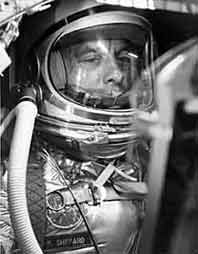- NASA Home
- | Centers
- | Kennedy Space Center
- | Kennedy History
Feature
In Their Footsteps: The Mercury 7
12.19.05
 As we stand on the threshold of new exploration of the moon, Mars and beyond, we are reminded of the first American space explorers who bravely paved the way: the original Mercury 7 astronauts. These adventurers, and a quiet spot on Florida's east coast, were destined to become the focus of the new Space Age.
As we stand on the threshold of new exploration of the moon, Mars and beyond, we are reminded of the first American space explorers who bravely paved the way: the original Mercury 7 astronauts. These adventurers, and a quiet spot on Florida's east coast, were destined to become the focus of the new Space Age. Image at Right: The first American manned space program was named Project Mercury. Image credit: NASA
The first national manned space flight project, later named Project Mercury, was born on Oct. 7, 1958. The program spanned nearly five years, with six manned missions making history between May 1961 and May 1963. In that short time, NASA achieved its goals for the project:
- Orbit a manned spacecraft around Earth
- Investigate man's ability to function in space
- Recover both man and spacecraft safely
 Image at Left: America’s first astronauts: (front row) Walter M. Schirra Jr., Donald K. "Deke" Slayton, John H. Glenn Jr., Scott Carpenter, (back row) Alan B. Shepard Jr. , Virgil I. "Gus" Grissom and L. Gordon Cooper. Image credit: NASA
Image at Left: America’s first astronauts: (front row) Walter M. Schirra Jr., Donald K. "Deke" Slayton, John H. Glenn Jr., Scott Carpenter, (back row) Alan B. Shepard Jr. , Virgil I. "Gus" Grissom and L. Gordon Cooper. Image credit: NASA The American public first met the seven men chosen to be this country's first human space voyagers on April 9, 1959, at a press conference in Washington. The men were dubbed "astronauts." The term was a cross between "aeronauts," as ballooning pioneers were called, and "Argonauts," the legendary Greeks in search of the Golden Fleece. These new explorers were being prepared to sail into the new, uncharted vastness of space.
Take a look back at how they trained and launched from what was to become America's spaceport.

Image at Right: The selected seven astronauts go through survival training in the Nevada desert. Each astronaut was left there for four days with a mockup of a Mercury spacecraft, a parachute and a survival scenario. Image credit: NASA

Image Above: The hard-packed sands of the Space Coast proved good for running, as Mercury astronaut John Glenn discovered. Image credit: NASA

Image at Left: Inside his Freedom 7 capsule atop a Redstone rocket, Astronaut Alan Shepard undergoes a flight simulation test. Image credit: NASA

Image at Right: Liftoff of the Mercury-Atlas rocket from Pad 14 at Cape Canaveral marked the first American manned orbital space flight carrying astronaut John Glenn. Image credit: NASA

Image at Left: Mercury Control Center at Cape Canaveral not only was the nerve center for each launch, but also for the entire mission. Image credit: NASA

Image Above: Families of the Mercury 7, like the loved ones of Astronaut Scott Carpenter seen here welcoming him home, also found themselves in the spotlight. Image credit: NASA

Image Above: Returning astronauts were welcomed by parades like this one for Astronaut Gordon Cooper at Patrick Air Force Base, just south of Cape Canaveral. Image credit: NASA

Image Above: After the last "splashdown" of the Mercury program, Astronaut Gordon Cooper is helped out of his spacecraft, Faith 7, aboard the recovery ship. Image credit: NASA
 Among the original Mercury 7 astronauts, only Deke Slayton didn't make a Mercury flight, but he did go on to fly in space as part of the Apollo-Soyuz Test Project crew.
Among the original Mercury 7 astronauts, only Deke Slayton didn't make a Mercury flight, but he did go on to fly in space as part of the Apollo-Soyuz Test Project crew. Image at Right: In 2002, Mercury 7 Astronauts (from left) Wally Schirra, Gordon Cooper, John Glenn and Scott Carpenter were among space pioneers honored during the 40th anniversary celebration of American space flight at the Kennedy Space Center. Image credit: NASA
In all, three members of the Mercury 7 also flew in the Gemini program and three were part of Apollo missions, with Shepard setting foot on the moon.
Glenn's return to space came 36 years after his first flight. He lifted off aboard space shuttle Discovery for mission STS-95 in 1998.
To this day, every manned mission launched by NASA -- as well as frequent unmanned launches -- have one thing in common: they have lifted off from that same point of land on Florida's east coast
+ Learn more -- read This New Ocean: A History of Project Mercury
NASA's John F. Kennedy Space Center